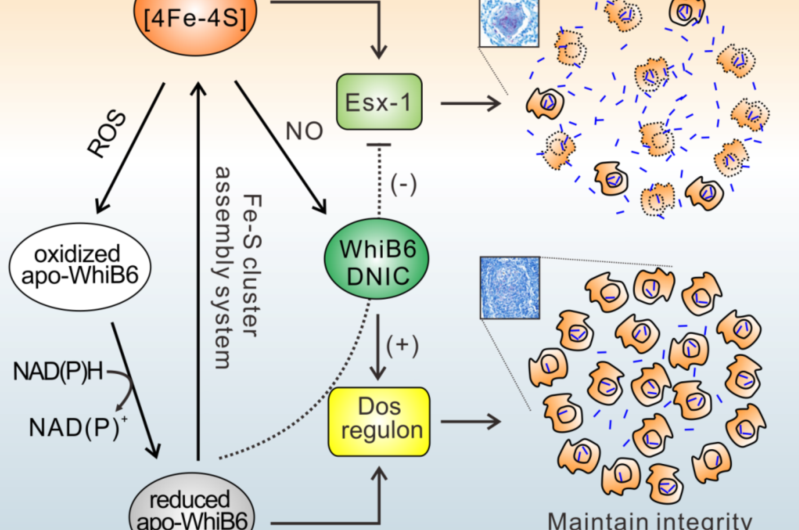Chinese researchers reveal redox sensor protein role in pathogenic mycobacteria

As one of the most successful intracellular pathogens, Mycobacterium tuberculosis (Mtb) causes 8 million cases of tuberculosis and 1.3 million deaths worldwide annually. During the course of infection, Mtb is exposed to diverse redox stresses that trigger metabolic and physiological changes.
However, it remained unclear how these stressors are sensed and relayed to the Mtb transcriptional apparatus. Researchers already knew that the ESX-1 secretion system encoding a type VII secretion system is unique to mycobacteria and is required for acute infection, while the DosRS regulon is required for long-term persistence in Mtb.
Furthermore, association of nitric oxide (NO) produced by host cells and upregulation of DosR as well as whiB6 has been documented, but how this happens remained to be elucidated.
New research carried out by scientists with the Center for Emerging Infectious Diseases, Wuhan Institute of Virology (WIV) of the Chinese Academy of Sciences, dissects the cellular role of WhiB6, one of the WhiB redox sensor family proteins, in virulence and intracellular survival of pathogenic mycobacteria.
Their study was published online on August 18 in Cell Reports.
"Using the M. marinum-zebrafish infection model, we provide compelling evidence showing that WhiB6 acts as a finely tuned regulator of the ESX-1 secretion system and DosR regulon with its Fe-S cluster in response to NO," said CHEN Zhenkang, first author of the paper.
As Mtb infection worsens, infected macrophages activate additional macrophages and other immune cells to form a granuloma, which is an organized collection of macrophages composed of mononuclear phagocytes, dendritic cells, as well as T and B lymphocytes.
"Our study reveals that WhiB6 regulation has altered function due to change toward its Fe-S cluster, which enables mycobacteria to establish persistent infection and maintain integrity of the granulomas. We propose a model to explain how WhiB6 plays in different regulatory roles to modulate the development of granulomas," said Dr. CHEN Shiyun, a principal investigator and the corresponding author of the paper.
"Our work is of great interest not only to the specific field of mycobacteriology, but also to the broader readership interested in host-pathogen interaction and related mechanisms," he said.
More information: Mycobacterial WhiB6 Differentially Regulates ESX-1 and the Dos Regulon to Modulate Granuloma Formation and Virulence in Zebrafish Published:,Cell Reports August 18, 2016. DOI: 10.1016/j.celrep.2016.07.080



















